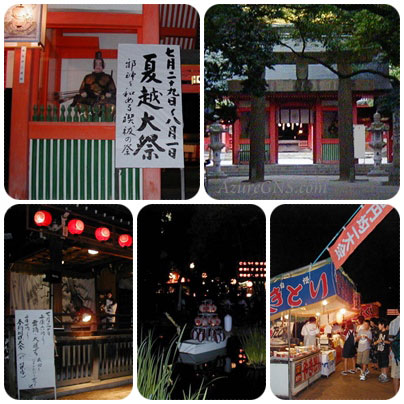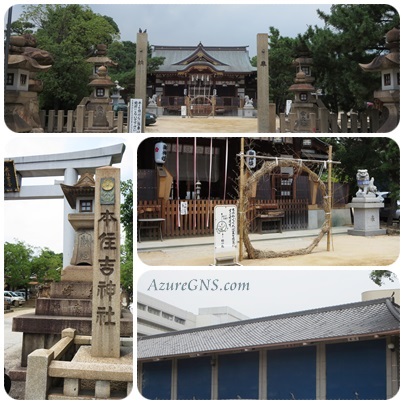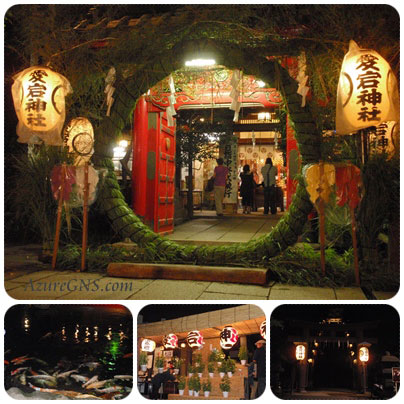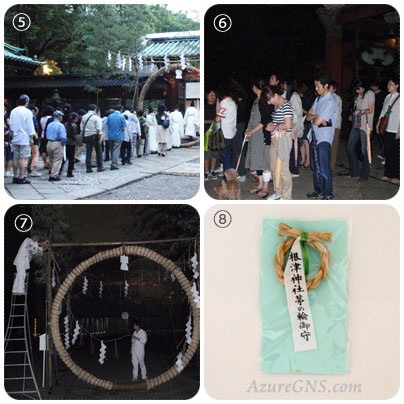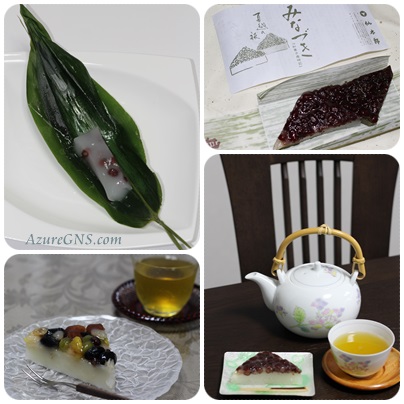Wagaya no Nagoshi-no-harae;
Our Great Summer Purification Experience
住吉神社は全国に約2,300社あり、航海の神様として信仰されています。その総本社は大阪市住吉区にあり、住吉大社と呼ばれています。この住吉大社は福岡市博多区の住吉神社と山口県下関市の住吉神社と共に、日本三大住吉の一社に数えられます。夫の転勤で4年間福岡市に住んでいる時に、家族で福岡市博多区にある住吉大社の名越大祭(なごしたいさい)に行きました。他の多くの「夏越」と違い「名越」と書きます。茅の輪くぐり、形代流し、赤ちゃんの土俵入りなどの神事が行われていました。境内に出ていた屋台で、小学生だった息子はゲーム、くじ引き、食べ物を楽しみました。
There are about 2,300 Sumiyoshi Shrines all over Japan, which are worshiped as the god of voyages. Its grand head shrine is located in Sumiyoshi Ward, Osaka City and is called Sumiyoshi Taisha Shrine. It is counted among the three major Sumiyoshi Shrines in Japan along with Sumiyoshi Shrine in Hakata Ward, Fukuoka City and Sumiyoshi Shrine in Shimonoseki City, Yamaguchi Prefecture. While I was living in Fukuoka City for 4 years because of my husband’s transfer, my family and I went to Nagoshi-taisai (the Great Summer Purification) held by the Sumiyoshi Shrine in Hakata Ward. Unlike many other shrines, this shrine doesn’t use “夏越” (Chinese characters for Nagoshi; 夏 means “summer”) but uses “名越” (名 means “name”). The Shinto rituals were held such as Chino-wa-kuguri, Katashiro-nagashi and Akachan-no-dohyo-iri (the ceremony of babies’ entering the sumo ring). My son, who was an elementary student then, enjoyed games, a lottery and food at stalls in the precincts.
本住吉神社は兵庫県神戸市東灘区にあります。この神社はだんじりで有名です。西日本特有の呼称で、神社に奉納される祭礼の巡行で引いたり担いだりする装飾がほどこされた山車のことです。毎年、5月4日と5日には境内の車庫に保管されている7台のだんじりの巡行が行われます。1995年(平成7年)阪神・淡路大震災が起こり、その後しばらくの間、本住吉神社のすぐ近くのJR住吉駅から西は電車が不通になっていました。神戸の実家に帰るために、JR住吉駅で電車を下りてバスに乗り換える時、本住吉神社が地震によって大きな被害を受けているのを見てとてもショックでした。鳥居、拝殿、絵馬堂、手水舎、塀も壊れていましたが、後に復興しています。本住吉神社の夏越の祓は、大阪市の住吉大社同様に7月末に行われます。私が夏越の祓のお参りに行った時は、だんじりの時と違って人の姿はほとんど見られませんでした。
Moto-Sumiyoshi Shrine is located in Higashinada Ward, Kobe City, Hyogo Prefecture. This shrine is famous for its Danjiri (which means Dashi in the dialect of the western part of Japan and is a kind of decorative float in a festival parade which is dedicated to the shrine). On May 4th and 5th every year, there are parades of the seven Danjiri which are usually stored in warehouses in the precincts of the shrine. In 1995 (Heisi 7th yr), the Great Hanshin-Awaji Earthquake occurred, and for a while afterwards, JR West train services were suspended westward from JR Sumiyoshi Station near Moto-Sumiyoshi Shrine. When I got off the train at JR Sumiyoshi Station near Moto-Sumiyoshi Shrine and changed to the bus on my way to my parents’ home, I was shocked to see that the shrine badly damaged by the earthquake. Torii (a shrine gate), haiden (a worship hall), ema-do (a hall for small wooden boards on which one writes his or her wishful prayer, name and address, and offer it to a shrine or a temple), chozu-ya (a water ablution pavilion in the shrine for cleaning a visitor’s hands and rinsing his or her mouth) and the walls were destroyed though they were reconstructed later.
Nagoshi-no-harae at Moto-Sumiyoshi Shrine is held at the end of July as well as at Sumiyoshi Taisha Shrine in Osaka City. When I visited its Nagoshi-no-harae, there were few people were seen there unlike the Danjiri festival.
東京都港区の愛宕神社では、毎年6月23日の夜から24日の早朝にかけて千日詣りが行われます。この日に社殿前に設けられた茅の輪をくぐり参詣すれば千日分の御利益があるとされています。同時に境内でほうずき市が開かれます。ほうずきは平安時代(794-1185)より薬草として用いられ、風邪、急な腹痛、子供の疳の虫を和らげるために煎じて飲まれていますが、現代はあまり使われていません。ほうずき市といえば浅草寺が有名ですが、港区の愛宕神社のほうずき市が今では各地で開催されているほうずき市の始まりと謂われています。2009年(平成21年)にテレビで千日詣りのニュースを見て、愛宕神社へお参りに行ってきました。標高25.7mの低い山といえども息を切らして上っていくと、提灯に照らされた青々と美しい茅の輪が迎えてくれました。後分かったことですが、エレベーターで上がることもできたようです。
Sennichi-mairi Festival is held at the Atago Shrine in Minato Ward, Tokyo from the evening of June 23rd to the early morning of the 24th every year. It is said that if visitors go through Chi-no-wa placed in front of the main building of the shrine and worship on these days, they can obtain as many benefits as those of one thousand visits. During Sennichi-mairi, Hozuki-ichi (a ground-cherry fair) is also held.
Hozuki have been used as a medicinal herb to relieve the symptoms of cold, sudden stomachache and children’s convulsions since the Heian Period (794-1185), but not so often in modern times. Speaking of Hozuki-ichi, the fair in the Senso-ji Temple is very famous, but the fair held in the Atago Shrine in Minato Ward is said to be the origin of other Hozuki-ichi now held in various regions. In 2009 (Heisei 21st yr), I visited the Atago Shrine to worship after I watched the news of Sennichi-mairi on television. Though the mountain on which the shrine was located was very low, 25.7m above sea level, I lost my breath climbing up to the beautiful green Chi-no-wa lighted up with lanterns. Later, to my surprise, I found out that there was an elevator to the shrine.
東京十社の一社に数えられている、文京区の根津神社は1900年余り昔に、日本武尊(やまとたける)によって創祀されたと伝えられています。ここは5代将軍徳川綱吉の兄である甲府中納言綱重の屋敷跡でした。そして6代将軍家宣の生誕の地でもあり、根津神社は家宣の産土神(うぶすながみ)となりました。1706年に完成した本殿、拝殿、唐門、楼門など多くの建築物が現存しており、国の重要文化財に指定されています。夏目漱石、森鴎外、高村光雲、寺田寅彦など多くの文豪の作品に登場します。こちらの神社は息子の厄除け参りでもお世話になりました。2009年(平成21年)6月30日、家族一緒に根津神社の夏越の祓に行きました。
Nezu Shrine, one of the ten major shrines in Tokyo, in Bunkyo Ward was said to have been established by Yamato Takeru more than 1900 years ago. It used to be the residence of Kofu Chunagon Tsunashige, an elder brother of the fifth Shogun Tokugawa Tsunayoshi. And also, the sixth Shogun Ienobu was born in this place, therefore this shrine was chosen as the tutelary deity of his birthplace.
The many shrine buildings built in 1706 such as the main building, the worship hall, the Chinese-style gate and the two-story gate still exist and are designated as important national cultural properties. Many great writers including Natsume Soseki, Mori Ogai, Takamura Koun and Terada Torahiko wrote about this shrine in their novels and essays. My son went to pray at this shrine for avoidance of bad luck on ages when it is said that unlucky events are likely to happen. On June 30th, 2009 (Heisei 21st yr), my family and I went to Nagoshi-no-harae in Nezu Shrine.
(1) 茅の輪くぐりを待つ人の列は鳥居の外まで続きました。
(1) The lines for Chi-no-wa-kuguri extended out of the torii (the shrine gate).
(2) 宮司を先頭に茅の輪を8の字を描くようにくぐりました。
(2) The chief Shinto priest led the people to pass through Chi-no-wa so as to draw the letter 8.
(3) 参拝者がとても多いので長時間待たなければいけませんでした。
(3) There were so many worshipers that we had to wait for a long time.
(4) 3回茅の輪をくぐった後、神主達は神前まで直進します。
(4) After going though Chi-no-wa three times, the Shinto priests went straight to the altar.
(5) 参拝者も神官に続いて神前に進みました。
(5) We went to the altar following the Shinto priests.
(6) 拝殿の前でもしばらく待たなければいけませんでした。
(6) We had to wait again in front of the worship hall for a while.
(7) 夏越の祓が終わるとすぐに茅の輪は取り除かれました。
(7) Soon after Nagoshi-no-harae was over, Chi-no-wa was removed.
(8) 茅の輪御守をいただきました。
(8) We were given the charms of Chi-no-wa.
名越の祓といえば、特に関西地方では水無月と呼ばれる和菓子を思い出す人が多いでしょう。本来、水無月は白い外郎に甘く煮た小豆を乗せ、氷をかたどった三角形に切ったものです。最近は、抹茶風味の水無月や、黒豆や金時豆などさまざまの豆を載せたものや、四角い水無月を笹で包んだものも売られています。
Speaking of Nagoshi-no-harae, many people, especially in the Kansai Area, remember Japanese sweets, minazuki. Originally, minazuki is white uiro (traditional chewy Japanese steamed cake made of rice flour and sugar) topped with sweetened red beans and cut into a triangular shape resembling ice. These days, we can buy minazuki with maccha (Japanese powdered green tea) flavor, minazuki topped with various sweetened beans such as kuro-mame (black soybeans) and kintoki-mame (red kidney beans) and square minazuki wrapped with a bamboo leaf.
(「夏越の祓」へ戻ります。)
(Back to “The Great Summer Purification”.)
Copyright (C) Azure Global Network Services. All Rights Reserved.
